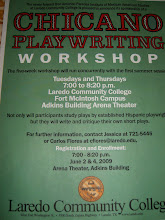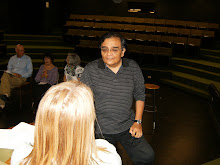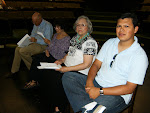___Américo Paredes is generally recognized as one of the seminal Mexican American scholars of the 20th century. Along with George I. Sánchez, Arthur León Campa, Julian Samora, fellow Texan Carlos Castañeda, and others he helped develop the foundations of modern Mexican American scholarship with his outstanding scholarly contributions. From mid-century onward his studies of corridos, folkloric ballads, machismo, and border stereotypes of Mexicanos formed the basis of a whole school of southwestern folklore most of whose investigators he trained.
Paredes was born in Brownsville, Texas on 3 September 1915 at a time of great border tension and violence resulting from the 1910 Mexican Revolution. His father, Justo Paredes, came from a ranching family that had settled on both sides of the lower Rio Grande valley in the mid-1700s after nearly two centuries as part of a Sephardic colony in Nuevo León. His mother's family had come from Spain around 1850; Clotilde Manzano-Vidal named their son Américo after the great 16th century Italian geographer and explorer because of a promise made to an aunt who was married to an Italian sailor.
One of eight children, Paredes received his early education in the public schools of his native Brownsville, Texas. After school hours he worked at various jobs to help support the family. In the evenings during summer vacations he often listened to corridos, folk tales, and oral traditions recounted by border "Mexicanos" around the campfire. In high school he later recalled first encountering anti-Mexican discrimination and racism. Among the more traumatic incidents was the racist presumption of his high school counselor that he would not go on to college. It almost deterred him. However, encouraged by a more sympathetic teacher and by winning first prize in a statewide poetry contest, he enrolled in Brownsville Junior College upon graduation from high school in 1934. While attending college he began working for the Brownsville Herald as a proofreader, translator and staff writer. Here he also met with discrimination, an ongoing experience that led to his lifelong energetic fight against ethnic bias and discrimination.
In 1935 at age 20 Paredes began seeing the poetry he had begun writing in high school published in the literary supplement to La Prensa in San Antonio. Two years later his first book of poetry, Cantos de adolescencia, came out. In the early 1940s Paredes married Consuelo (Chelo) Silva, a celebrated local singer, for a brief period and through this union a son was born. While continuing his job at the Herald, in 1940 he also accepted employment by Pan American Airways in work related to World War II.
Paredes resigned both jobs in 1944 to enter the U.S. Army as an infantryman. At the end of the war he was assigned to the army journal, Stars and Stripes and was sent to Tokyo to cover the war crimes trials. In the last year of his service he was appointed political editor of the Pacific edition of Stars and Stripes.
Upon taking his military discharge in Japan, Américo worked for the Red Cross as a specialist in public relations. It was during this time that he met his future wife, Amelia Nagamine, a young woman of Japanese-Uruguayan heritage, who also was working for the Red Cross in the same building. They initially were introduced by friends who wished to acquaint the two, since both were Spanish speakers and it was thought that they might enjoy conversing in Spanish. Before returning to the United States in 1950 he married Amelia, to whom he remained married for the rest of his life, more than 50 years, and together they had three children. A well matched couple, Amelia spent many years advocating in the state legislature and with the Austin State School in support of the mentally retarded.
Back in the United States, Paredes began to fulfill his dream of becoming a professor of English. Enrolling in The University of Texas at Austin, he was graduated, summa cum laude, in one year, completed his M.A. in English and folklore studies two years later, and in 1956 received his doctorate in those same fields. He then taught one year at Texas Western College, now The University of Texas at El Paso, before returning to Austin to accept a tenure track position teaching folklore and creative writing. During his first year of teaching at Austin his doctoral dissertation on Gregorio Cortez, the Tejano hero of a border corrido, was published by the university press. Titled With His Pistol in His Hand: A Border Ballad and its Hero, it was an immediate and outstanding success and brought him widespread recognition and peer respect. Later his Folktales of Mexico, 1970 and A Texas Mexican Cancionero: Folksongs of the Lower Border, 1976 assured his scholarly reputation.
Paredes spent the rest of his academic career in The University of Texas at Austin. In 1967 he helped found the Center for Intercultural Studies of Folklore and Ethnomusicology there. During the 1960s he also fought determinedly for creation of a Mexican American studies program in spite of discouraging anti-Mexican attitudes within the university. A colossus in the anthropology and English departments, he was named the Ashbel Smith Professor of English and Anthropology at the beginning of the 1980s and then the Dickson, Allen, and Anderson Centennial Professor in 1983.
Because of his outstanding skills and contributions in the field of folklore, in 1962 Paredes received a Guggenheim fellowship and five years later was invited to teach at the University of California, Berkeley as a distinguished visiting scholar. From 1968 to 1973 he served as editor of the Journal of American Folklore in which many of his 60-some scholarly articles were published.
An ethnic activist since his youthful days in Brownsville, Paredes persistently pursued his goal of validating Mexican American studies in the university. In spite of opposition, he continued his crusade, challenging the entrenched "old boy" network of his Anglo colleagues. Finally in 1970, with help from other Chicano faculty and graduate students, he succeeded in convincing the administration to authorize creation of a center for Mexican American studies. He was named its first director. His struggle for "la raza" (Hispanics) did not end there; he continued to fight against the historically and institutionally ingrained discrimination against "Mexicanos" widely prevalent in Texas. Twice in the early 1970s he tendered his resignation when he felt his suggestions were ignored or not given serious consideration by university administrators.
An outstanding teacher, Américo Paredes was a gentle, soft-spoken man who usually kept his intense feelings about discrimination and ethnic bias under wraps. His dignified, courtly demeanor masked a deep-seated indignation and at times anger over discrimination. At UT Austin he trained an entire generation of borderland folklorists and imbued them with his strong sense of the unfairness of ethnic discrimination.
Paredes's seminal importance was recognized in 1989 when he became the first Mexican American to receive the prestigious Charles Frankel Prize from the National Endowment for the Humanities for a lifetime devoted to a deeper understanding of the humanities. In the following year he was awarded the Order of the Aguila Azteca by the Mexican government for his work in preserving border culture and for his lifelong defense of human rights. In 1991 he was again honored by Mexico, with the Order of José de Escandón. Two years later The University of Texas dedicated to him a two-day symposium titled "Regional Identity and Cultural Tradition: The Tejano Contribution." It quite properly included a folkloric concert in his honor.
Subsequent to his retirement from teaching Paredes actively continued to research, write, and publish. In 1990 he came out with George Washington Gómez: A Mexicotexan Novel, followed in the next year by a book of his poems, Between Two Worlds. In 1993 he had two publications: Uncle Remus con chile, a compilation of Mexicano border humor, and a scholarly collection of articles, Folklore and Culture on the Texas-Mexican Border. In 1994 his The Hammon and the Beans and Other Stories was published and four years later his final work of fiction, The Shadow came out. On Cinco de Mayo 1999 Américo Paredes died after a lengthy illness.
Subscribe to:
Post Comments (Atom)






Paredes stood up for a lot in his time. Very difficult to say and write what he said during that time.
ReplyDelete"With a Pistol in His Hand" remains a favorite of mind